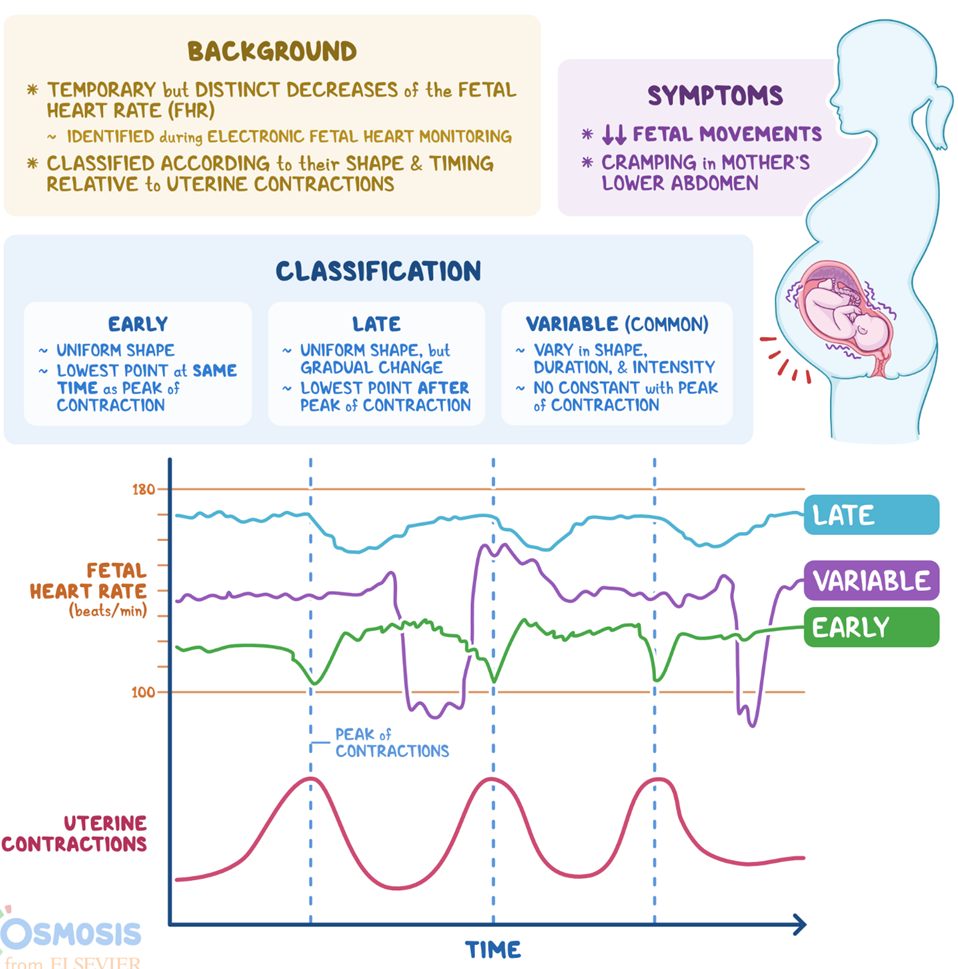A nurse is observing the electronic fetal heart rate monitor tracing for a client who is at 40 weeks of gestation and is in labor. The nurse should suspect a problem with the umbilical cord when she observes which of the following patterns?
Accelerations
Early decelerations
Late decelerations
Variable decelerations
The Correct Answer is D
The correct answer is D. Variable decelerations.
A. Accelerations in the fetal heart rate are generally considered reassuring. Accelerations are an indication of fetal well-being and are often seen in response to fetal movement.
B. Early decelerations are typically associated with head compression during contractions and are considered a normal response to the pressure on the fetal head.
C. Late decelerations are indicative of uteroplacental insufficiency.
Late decelerations occur after the peak of the contraction and are associated with inadequate oxygenation to the fetus. This pattern raises concerns about the baby's well-being.
D. Variable decelerations are associated with umbilical cord compression.
Variable decelerations are abrupt decreases in the fetal heart rate that vary in duration, depth, and timing. They often coincide with contractions and suggest compression or occlusion of the umbilical cord.

Nursing Test Bank
Naxlex Comprehensive Predictor Exams
Related Questions
Correct Answer is B
Explanation
The correct answer is B. Just above the symphysis pubis.
A. Just above the umbilicus: At the end of the first trimester, the uterus is still within the pelvic cavity, and fetal heart tones are typically not detectable above the umbilicus at this stage.
B. Just above the symphysis pubis: This is the correct placement for assessing fetal heart tones during the first trimester. The fetal heart is usually located low in the pelvis during early pregnancy, making it most easily heard just above the pubic bone.
C. The right lower quadrant: Fetal heart tones are typically assessed in the midline of the abdomen, and focusing on the lower quadrants may not be the optimal location, especially in the first trimester.
D. The left lower quadrant: Similar to the right lower quadrant, focusing on the lower quadrants may not be the most appropriate location for assessing fetal heart tones during the first trimester.
Correct Answer is C
Explanation
The correct instruction is C. "Check the temperature of your baby's bath water with your hand."
Explanation:
A. "You can share your room with your baby for the next few weeks": This is a recommended practice. The American Academy of Pediatrics (AAP) recommends room-sharing without bed-sharing for at least the first six months and ideally for the first year of a baby's life. It promotes safe sleep and reduces the risk of Sudden Infant Death Syndrome (SIDS).
B. "Cover your baby with a light blanket while sleeping": This instruction is not recommended. The AAP advises against using loose bedding, including blankets, in the sleep environment to reduce the risk of SIDS. It is safer to use sleep sacks or wearable blankets if additional warmth is needed.
C. "Check the temperature of your baby's bath water with your hand": This is the correct instruction. It is essential to ensure that the bathwater is not too hot to prevent burns. Checking with the hand is a practical way to assess the water temperature before placing the baby in the bath.
D. "Your baby can nap in the car seat during the daytime": While napping in a car seat during travel is acceptable, it is not recommended for routine or prolonged sleep. The upright position in a car seat may compromise the baby's airway, increasing the risk of breathing difficulties. It's advised to transfer the baby to a flat, firm sleep surface for regular naps.
Whether you are a student looking to ace your exams or a practicing nurse seeking to enhance your expertise , our nursing education contents will empower you with the confidence and competence to make a difference in the lives of patients and become a respected leader in the healthcare field.
Visit Naxlex, invest in your future and unlock endless possibilities with our unparalleled nursing education contents today
Report Wrong Answer on the Current Question
Do you disagree with the answer? If yes, what is your expected answer? Explain.
Kindly be descriptive with the issue you are facing.
